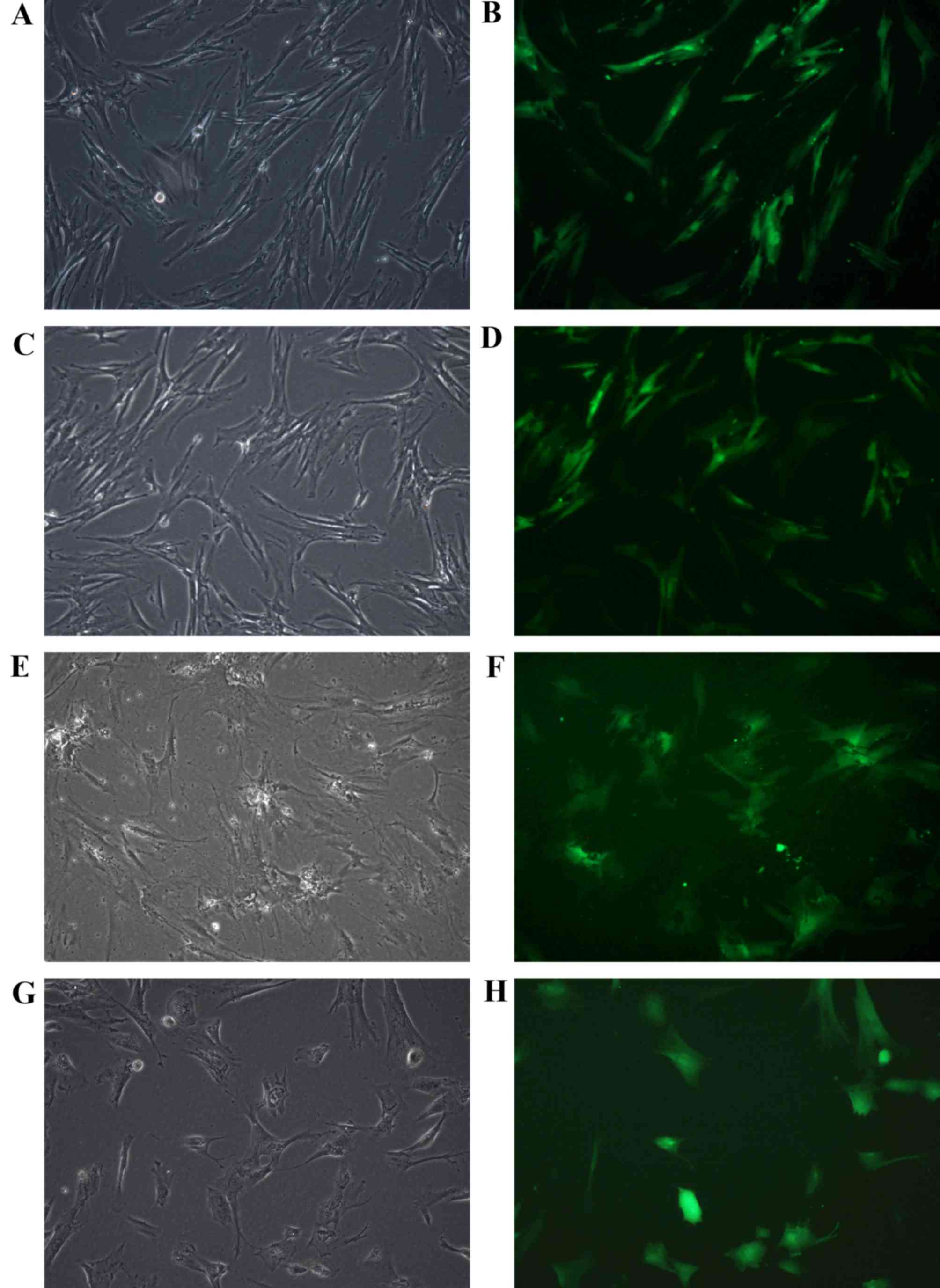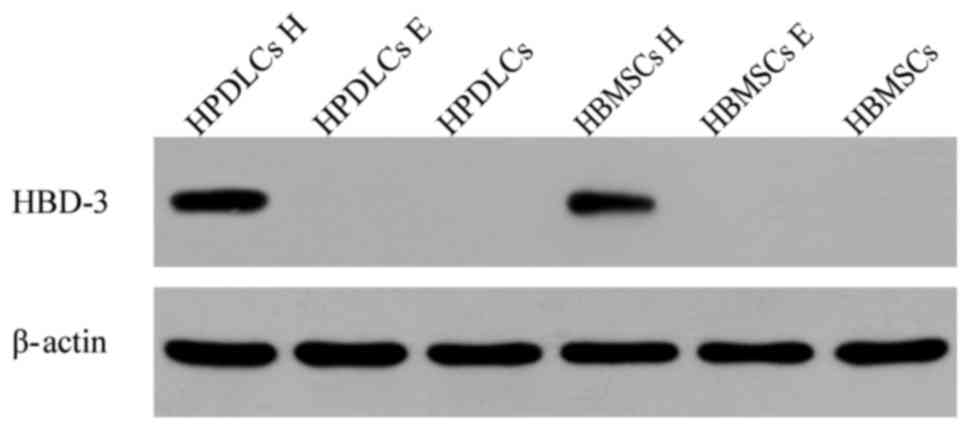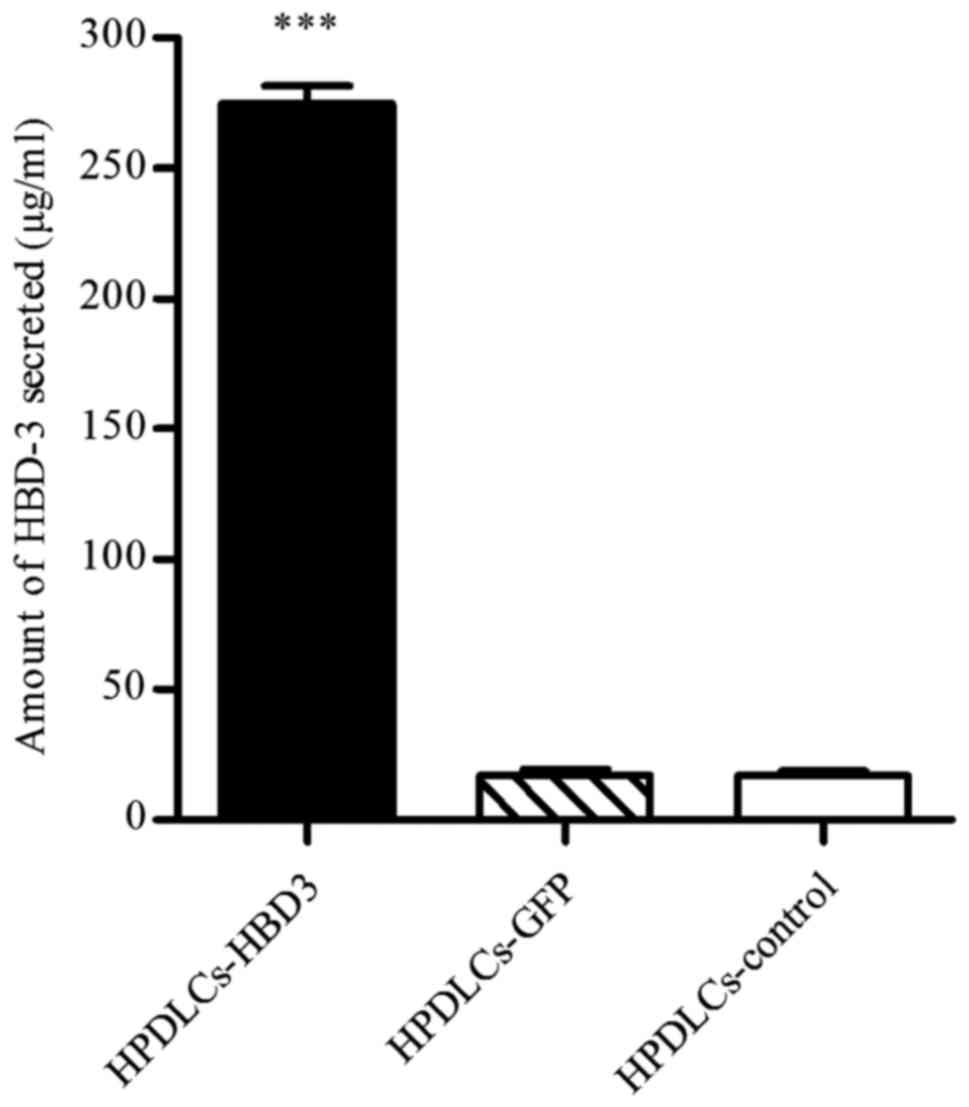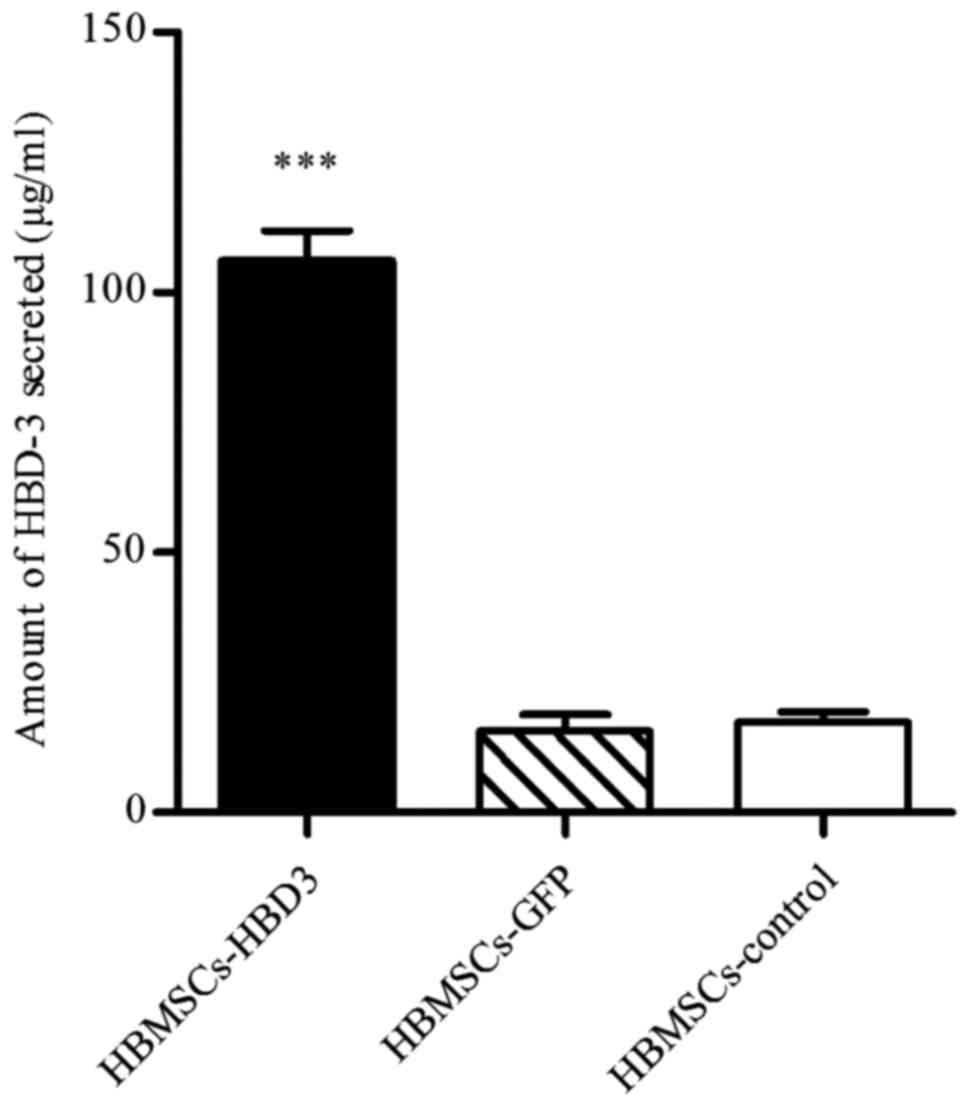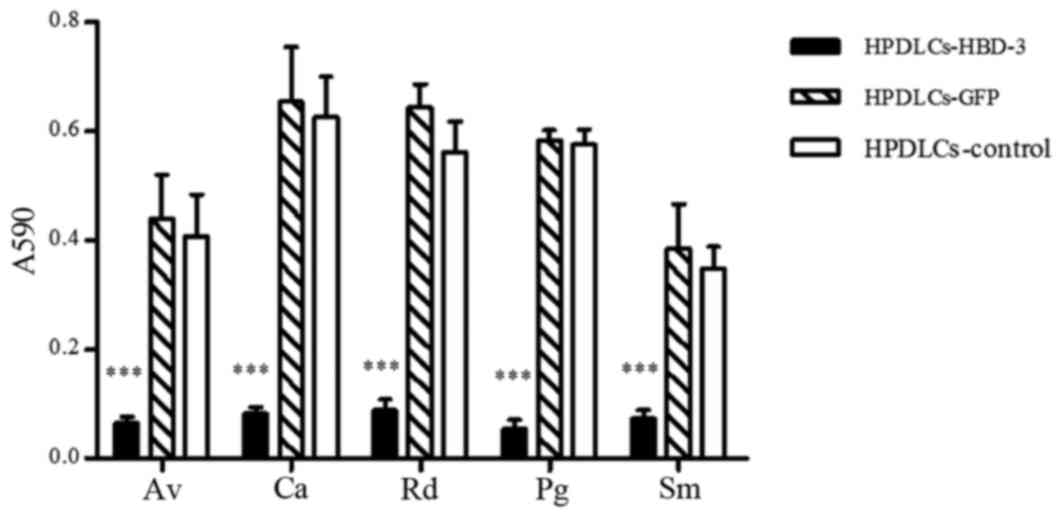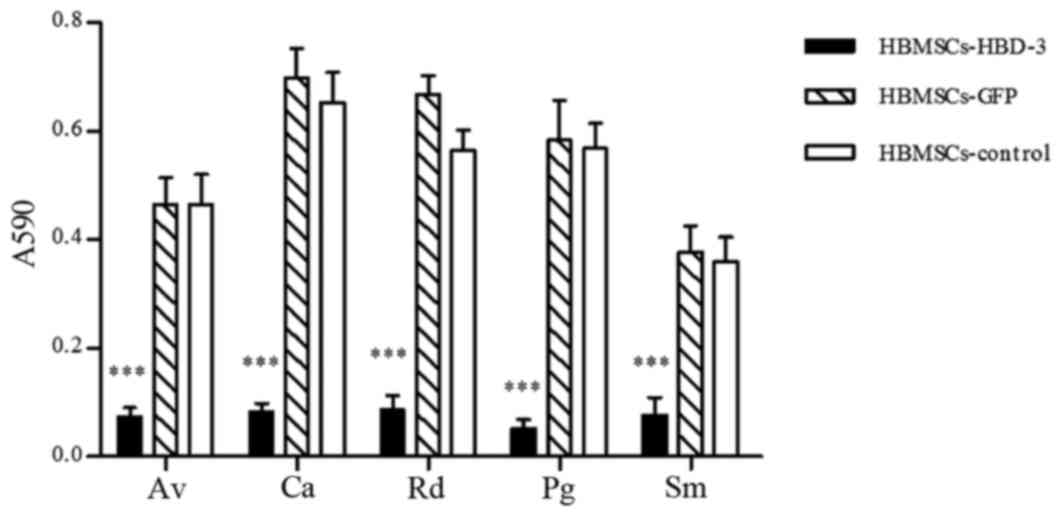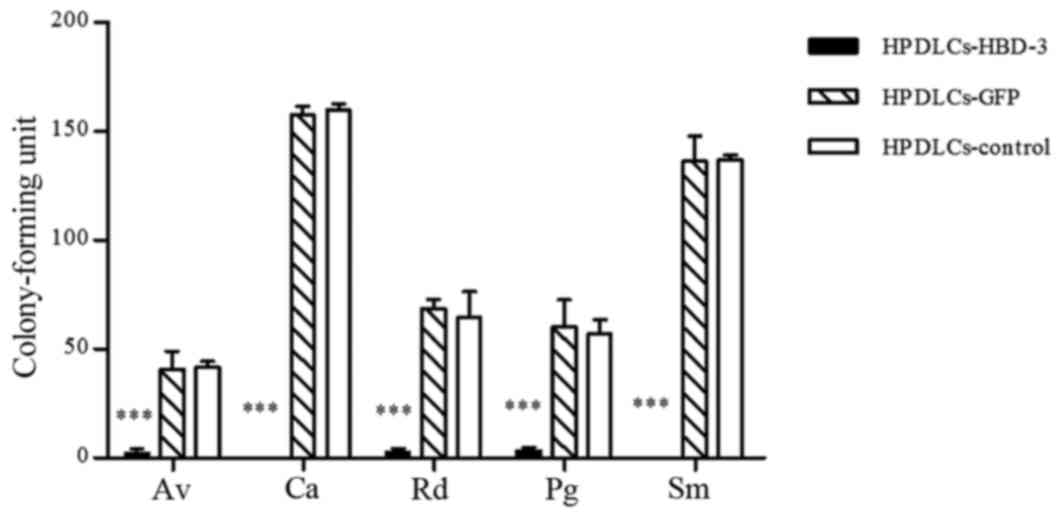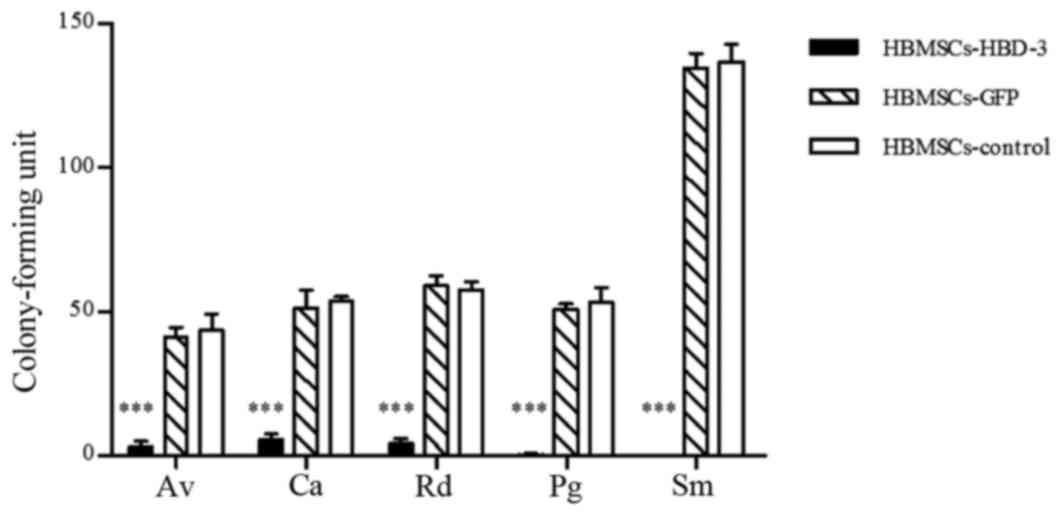Expression and antimicrobial character of cells transfected with human β‑defensin‑3 against periodontitis‑associated microbiota in vitro
- Authors:
- Published online on: July 4, 2017 https://doi.org/10.3892/mmr.2017.6913
- Pages: 2455-2460
-
Copyright: © Zhu et al. This is an open access article distributed under the terms of Creative Commons Attribution License.
Abstract
Introduction
Periodontitis is caused by a wide range of complex microorganisms and is the primary cause of alveolar bone absorption and eventual tooth loss in the adult population (1). This condition has become a major public health issue, and the development of effective therapies to treat this disease and regenerate periodontal tissue has become an important goal of current medicine. It is widely accepted that both the initiation of oral infectious diseases and the progression of these disease states are associated with increased diversity and richness of the microbiota. In contrast, oral health is associated with decreased diversity and richness within the microbial community. Furthermore, the immune response of the host to the oral microbiome should be considered with respect to the immunopathogenesis of periodontal disease and the immune defenses against caries (2). The inflammatory response fosters the growth of dysbiotic microbial communities, and the bacterial biomass of human periodontitis-associated biofilms has been shown to increase with the aggravation of periodontal inflammation (3). As periodontal tissue may continue to degrade even after being treated with conventional therapies (4), there is a need to develop an antimicrobial agent to protect regenerated periodontal tissue in infectious environments.
Human β-defensins (HBDs) are epithelial-derived antimicrobial peptides that contribute to the innate immune responses of eukaryotes (5). In addition to their microbicidal abilities, host defense peptides are multifunctional mediators of inflammation that have effects on cell proliferation, cytokine/chemokine production and chemotaxis in epithelial and inflammatory cells (6). The expression of three HBDs (namely HBD-1, −2 and −3) has been identified in oral mucosa, gingiva and salivary glands (7). Among these HBDs, HBD-3 is of particular interest for structural and functional studies, and for potential pharmaceutical applications. The broad-spectrum microbicidal activity of HBD-3 is effective against multiple organisms, including fungi, bacteria and viruses. Thus, HBD-3 plays an important role in the human body (8).
Recently, various approaches have been applied to regenerate periodontal tissue, including the use of osteoinductive agents and biomaterials, guided tissue regeneration and cell therapy (9). Human periodontal ligament cells (HPDLCs) and human bone marrow stromal cells (HBMSCs) are useful seeding cells for periodontal cell therapies (10,11). However, these two cell types only secrete HBD-3 in trace amounts (12).
The present study aimed to construct a recombinant lentiviral vector with the HBD-3 gene, and to investigate the effects of the vector in an effort to develop a novel and suitable treatment for periodontal inflammation to promote periodontal tissue regeneration.
Materials and methods
Cell isolation and culture
HPDLCs and HBMSCs were received as gifts from the Shanghai Research Institute of Stomatology (Shanghai, China). The cells were cultured in Dulbecco's modified Eagle's medium at 37°C in a humidified atmosphere of 95% air and 5% CO2. The medium was replaced the following day and subsequently every 3 days. The cells were passaged with 0.25% trypsin and 0.1% EDTA upon reaching confluence. Cells from passage three or four were used in the subsequent experiments.
Recombinant plasmid construction
The expression vector pLV.Des3d.P/puro was purchased from Cyagen Biosciences (Guangzhou, China). E. coli Stbl3 was used as the host. The HBD-3 gene (code: MRIHYLLFALLFLFLVPVPGHGGIINTLQKYYCRVRGGRCAVLSCLPKEEQIGKCSTRGRKCCRRKK) and the green fluorescent protein (eGFP) gene were cloned into the pLV.Des3d.P/puro vector. The recombinant plasmid pLV.EX3d.P/puro-EF1A- Humacalx-IRES/eGFP was constructed using Gateway Technology, as previously described (13). This technology was invented and commercialized by Invitrogen (Thermo Fisher Scientific, Inc., Waltham, MA, USA) and is a universal cloning method based on the site-specific recombination properties of bacteriophage λ. The recombinant plasmid pLV.EX3d.P/puro-EF1A-PTH-IRES/eGFP was constructed without HBD-3. The constructed expression plasmids were amplified in the E. coli strain Stbl3.
Transfection
The lentiviral vector containing HBD-3 was first transfected into 293T packaging cells to obtain high levels of lentiviral particles in the culture supernatant. The HPDLCs and HBMSCs were cultured in 25-cm2 dishes until 80–90% confluence was reached. Transfection was performed by adding polybrene (8 µg/ml) and 20 µl each viral dilution to the cells, thoroughly and gently mixing the solutions, and incubating the cells in 5% CO2 at 37°C. After 18 h, the viral particles remaining in the supernatant were removed and the medium was replaced with fresh medium supplemented with 10% fetal bovine serum (FBS; Gibco, Thermo Fisher Scientific, Inc.). The cells were incubated in 5% CO2 at 37°C for an additional 72 h. The transfection efficiency was calculated using a fluorescence microscope.
Western blot analysis
The cells were collected from the culture dishes with radioimmunoprecipitation assay lysis buffer (Beyotime Institute of Biotechnology, Haimen, China). Phenylmethanesulfonyl fluoride (Beyotime Institute of Biotechnology) was added to the samples, and a Bicinchoninic Acid assay was used to determine the protein concentrations. The samples were boiled at 100°C for 5 min. Total proteins (20 µg per lane) were separated by 5–15% SDS-PAGE and subsequently transferred onto polyvinylidene difluoride membranes. Membranes were blocked with 5% nonfat milk (5 g nonfat milk powder diluted in 100 ml PBS) for 1 h at room temperature and incubated overnight at 4°C with the following corresponding primary antibodies: Anti-β-actin (cat. no. ab1801; 1:1,000; Abcam, Cambridge, UK) and anti-β-defensin-3 (cat. no. ab19270; 1:1,000; Abcam), followed by incubation with a goat anti-rabbit IgG horseradish peroxidase-conjugated secondary antibody (cat. no. KC-RB-035; 1:5,000; KangChen Bio-tech, Inc., Shanghai, China) for 1 h at room temperature. After washing with TBS with Tween-20, the membranes were developed using an EZ-enhanced chemiluminescence detection kit according to the manufacturer's protocol (Biological Industries Beit Haemek Ltd., Israel) and were then imaged using a UVitec gel documentation system (UVitec Limited, Cambridge, UK).
Enzyme-linked immunosorbent assay (ELISA)
The amount of secreted HBD-3 in the culture supernatant was detected using an HBD-3 ELISA kit (cat. no. JL19214; Shanghai Jiang Lai Biotechnology Co., Ltd., Shanghai, China) according to the manufacturer's instructions. Absorbance at 490 nm was determined with a microplate reader (BioTek ELx800; Omega Bio-Tek, Inc., Norcross, GA, USA). Each sample was analyzed in triplicate.
Microbial strains
Actinomyces viscosus (ATCC 19246); Candida albicans (ATCC 10231); Rothia dentocariosa (ATCC 19426); Porphyromonas gingivalis (ATCC 33277) and Streptococcus mutans (UA 159) were used to test the antimicrobial activity of the cells. All the strains were received as gifts from the Shanghai Research Institute of Stomatology.
Antimicrobial activity as assessed by liquid growth inhibition assay
The antimicrobial activity of HBD-3 against the five microbial strains mentioned above was determined by a liquid growth inhibition assay. The purified HBD-3 peptide was serially diluted two-fold with 0.01% acetic acid and 0.2% bovine serum albumin (Thermo Fisher Scientific, Inc.). Aliquots (10 µl) from each dilution were transferred to a 96-well microplate, and each well was inoculated with 100 µl suspension of mid-log bacteria (106 CFU/ml) in brain heart infusion (BHI) broth (BBL, Cockeysville, USA). Medium alone (BHI broth) and untreated cells served as control groups. After the cultures were incubated at 37°C for 24 h, microbial growth was assessed by measuring the optical density at a wavelength of 590 nm with a microplate reader. All experiments were performed in triplicate.
Colony-forming assay
The suspensions of the tested microorganisms were separately cultured in BHI agar supplemented with 5% FBS at 37°C for 48 h. Subsequently, the number of colony-forming units (CFUs) was counted.
Statistical analysis
Data are expressed as the mean ± standard deviation. SPSS 19.0 software (IBM Corp., Armonk, NY, USA) was used for all statistical analyses. Significant differences were calculated using one-way analysis of variance followed by Bonferroni or Tamhane post hoc tests. P<0.05 was considered to indicate a statistically significant difference.
Results
Transfection efficiency
Fusiform or polygonal transfected HPDLCs and HBMSCs were observed adhering to the bottom of the dishes by optical microscopy (Fig. 1). Transfection of the recombinant plasmids into HPDLCs and HBMSCs was assessed by detecting GFP expression using a fluorescence microscope. The transfected HPDLCs and HBMSCs exhibited similar GFP-positive expression throughout several repeated experiments, as observed by fluorescence microscopy (Fig. 1). Transfection efficiency was calculated by counting the cells that fluoresced green. The results demonstrated that the rate of HPDLC and HBMSC transfection with the HBD-3 and GFP genes was 79.94 and 64.81%, respectively. The rate of HPDLC and HBMSC transfection with the GFP gene only was 75.98 and 53.71%, respectively (data not shown).
Western blot analysis
To examine the protein expression level of HBD-3 in the transfected HPDLCs and HBMSCs, western blot analysis was performed. Distinct positive bands were observed for HPDLCs and HBMSCs transfected with the HBD-3 and GFP genes. However, no positive bands were observed in the other two groups (Fig. 2).
ELISA
ELISA was performed to quantify the levels of HBD-3 in HPDLCs and HBMSCs transfected with the HBD-3 and GFP genes. The untreated cells served as a control. The results demonstrated that the concentration of secreted HBD-3 was 274.89±6.79 µg/ml and 106.11±5.67 µg/ml in the supernatants of transfected HPDLCs (Fig. 3) and HBMSCs (Fig. 4), respectively; these concentrations were significantly higher than those of the corresponding cells transfected with the GFP control vector, and that of the untreated control group (P<0.001).
Liquid growth inhibition assay
A liquid growth inhibition assay was performed, and the optical density of each stock suspension was measured at 590 nm to evaluate the approximate numbers of microbes present. As presented in Fig. 5, the HPDLCs transfected with the HBD-3 gene and cultured with Actinomyces viscosus, Candida albicans, Rothia dentocariosa, Porphyromonas gingivalis and Streptococcus mutans yielded small optical density (OD) values of 0.065±0.012, 0.081±0.013, 0.088±0.020, 0.054±0.017 and 0.073±0.016, respectively, which were significantly reduced compared with those of the other groups (P<0.001). A similar effect was observed for HBMSCs transfected with the HBD-3 gene and cultured with the microbes; corresponding to the order listed above, the cultures yielded OD values of 0.073±0.017, 0.082±0.016, 0.086±0.026, 0.052±0.017 and 0.076±0.033, respectively (P<0.001; Fig. 6).
Colony-forming assay
A colony-forming assay was performed to evaluate the effects of HBD-3 on the important antimicrobial activity of the cells against the tested bacteria. The HPDLCs transfected with the HBD-3 gene demonstrated significantly reduced colony counts compared with control and GFP-transfected HPDLCs (P<0.001; Fig. 7). Similar results were observed in HBMSCs (P<0.001; Fig. 8).
Discussion
Periodontal diseases are highly prevalent and affect <90% of the population worldwide (1). Pathogenic bacteria are widely recognized to be a major cause of periodontal tissue destruction, and the ultimate goals of periodontal treatments are to support good oral hygiene and regenerate tissue integrity, which may have been damaged by the inflammatory process (14). Currently, periodontal regeneration is shifting towards cell- and gene-based therapies (15). The present study constructed a recombinant lentiviral HBD-3 expression vector and investigated the effects of an antimicrobial peptide using a combination of gene- and cell-based therapies.
Firstly, the efficiency of HBD-3 transfection into HPDLCs and HBMSCs was determined, and transfection was validated using western blotting. HBD-3 protein levels in the transfected HPDLCs and HBMSCs were sustained and were significantly higher than those of the control group. Similar results were also obtained from the ELISA analyses. Certain studies have reported that HPDLCs have the capacity to function as osteoblasts or cementoblasts under regenerative conditions, suggesting that they are the best candidates for regeneration applications (16,17). In addition, HBMSCs are the most widely investigated mesenchymal stem cells, which have tremendous potential in regenerative medicine because of their multipotency and capability of forming a variety of tissues, including the periodontium (18). The crucial steps of gene therapy include the efficient transfer and appropriate expression of the target gene. Currently, the lentiviral vector is one of the most useful methods for treating periodontal disease by virtue of its high transduction efficiency (15). The studies mentioned above indicated that HPDLCs and HBMSCs are promising for use as seeding cells for cell- and gene-based therapies for periodontal disease. In addition, the lentiviral vector with eGFP is an appropriate expression vector system.
Furthermore, the present study detected the antimicrobial activity of the HPDLCs and HBMSCs transfected by a lentivirus containing the HBD-3 gene, using liquid growth inhibition and colony-forming assays. HBD-3 is an endogenous antibiotic and is active against both gram-positive and gram-negative bacteria. Its ability to act against multidrug-resistant clinical isolates of Staphylococcus aureus, Enterococcus faecium, Pseudomonas aeruginosa, Stenotrophomonas maltophilia, and Acinetobacter baumannii has been confirmed (19). In the present study, the numbers of bacteria were significantly lower in the experimental group than in the control group. The periodontal pathogens Actinomyces viscosus, Porphyromonas gingivalis, Rothia dentocariosa and Candida albicans (20–22) were demonstrated to be susceptible to the cells containing Humacalx-IRES compared with those in the control and untreated groups. The results indicated that HBD-3 has the capacity to inhibit microbial activity in vitro, which is consistent with the results of our previous study (23) and with other research (24). As Candida albicans is the most common opportunistic fungal pathogen of humans, and can cause superficial epithelial infections and life-threatening systemic infections, HBD-3 also demonstrated beneficial antifungal effects. Notably, the caries-causing bacteria Streptococcus mutans (2) was also susceptible to HBD-3 in both experimental groups. The results of the present study demonstrated the multifunctional, broad-spectrum activity of HBD-3 against a collection of oral microorganisms; this activity could be applied in the treatment of oral infectious diseases.
Cells of several human tissue types can secrete HBD-3. Previous studies have demonstrated that HBD is susceptible to degradation and inactivation by both host and bacterial proteases. It has also been reported that inflamed gingival tissues express lower levels of HBD-3 mRNA than healthy tissues (7,25). Brancatisano et al (26) detected HBD-3 using ELISA, and demonstrated that its levels were inversely correlated with the severity of the disease and with the degree of colonization by combinations of bacterial species having elevated periodontopathogenic potential. Based on this information, it is reasonable to hypothesize that aggressive inflammation and tissue destruction occur when the HBD-3 peptide cannot counteract the antimicrobial activity. However, appropriate expression of HBD peptides in states of health and disease may contribute to the maintenance of periodontal homeostasis, potentially via the antimicrobial effects of HBD-3 and the promotion of adaptive immune responses (27). Therefore, the transfection of HPDLCs and HBMSCs with HBD-3 may have favorable effects on antimicrobial activity by complementing the low levels of HBD-3 in aggressive periodontitis and other oral infectious diseases.
In conclusion, application of the lentiviral vector containing HBD-3 has great potential as a safe and efficient gene therapy for antimicrobial activity in periodontitis. Further research will be conducted to investigate the influence of HBD-3 transfection on HPDLCs and HBMSCs in periodontal tissue regeneration.
Acknowledgements
The present study was supported by the National Natural Science Foundation of China (grant no. 81271157).
References
|
Pihlstrom BL, Michalowicz BS and Johnson NW: Periodontal diseases. Lancet. 366:1809–1820. 2005. View Article : Google Scholar : PubMed/NCBI | |
|
Costalonga M and Herzberg MC: The oral microbiome and the immunobiology of periodontal disease and caries. Immunol Lett. 162:22–38. 2014. View Article : Google Scholar : PubMed/NCBI | |
|
Hajishengallis G: The inflammophilic character of the periodontitis-associated microbiota. Mol Oral Microbiol. 29:248–257. 2014. View Article : Google Scholar : PubMed/NCBI | |
|
Holmlund A, Hänström L and Lerner UH: Bone resorbing activity and cytokine levels in gingival crevicular fluid before and after treatment of periodontal disease. J Clin Periodontol. 31:475–482. 2004. View Article : Google Scholar : PubMed/NCBI | |
|
Taggart CC, Greene CM, Smith SG, Levine RL, McCray PB Jr, O'Neill S and McElvaney NG: Inactivation of human beta-defensins 2 and 3 by elastolytic cathepsins. J Immunol. 171:931–937. 2003. View Article : Google Scholar : PubMed/NCBI | |
|
Niyonsaba F and Ogawa H: Protective roles of the skin against infection: Implication of naturally occurring human antimicrobial agents beta-defensins, cathelicidin LL-37 and lysozyme. J Dermatol Sci. 40:157–168. 2005. View Article : Google Scholar : PubMed/NCBI | |
|
Bissell J, Joly S, Johnson GK, Organ CC, Dawson D, McCray PB Jr and Guthmiller JM: Expression of beta-defensins in gingival health and in periodontal disease. J Oral Pathol Med. 33:278–285. 2004. View Article : Google Scholar : PubMed/NCBI | |
|
Song W, Shi Y, Xiao M, Lu H, Qu T, Li P, Wu G and Tian Y: In vitro bactericidal activity of recombinant human beta-defensin-3 against pathogenic bacterial strains in human tooth root canal. Int J Antimicrob Agents. 33:237–243. 2009. View Article : Google Scholar : PubMed/NCBI | |
|
Li H, Yan F, Lei L, Li Y and Xiao Y: Application of autologous cryopreserved bone marrow mesenchymal stem cells for periodontal regeneration in dogs. Cells Tissues Organs. 190:94–101. 2009. View Article : Google Scholar : PubMed/NCBI | |
|
Dan H, Vaquette C, Fisher AG, Hamlet SM, Xiao Y, Hutmacher DW and Ivanovski S: The influence of cellular source on periodontal regeneration using calcium phosphate coated polycaprolactone scaffold supported cell sheets. Biomaterials. 35:113–122. 2014. View Article : Google Scholar : PubMed/NCBI | |
|
Osugi M, Katagiri W, Yoshimi R, Inukai T, Hibi H and Ueda M: Conditioned media from mesenchymal stem cells enhanced bone regeneration in rat calvarial bone defects. Tissue Eng Part A. 18:1479–1489. 2012. View Article : Google Scholar : PubMed/NCBI | |
|
Sutton JM and Pritts TA: Human beta-defensin 3: A novel inhibitor of Staphylococcus-produced biofilm production. Commentary on ‘Human β-defensin 3 inhibits antibiotic-resistant Staphylococcus biofilm formation’. J Surg Res. 186:99–100. 2014. View Article : Google Scholar : PubMed/NCBI | |
|
Hartley JL, Temple GF and Brasch MA: DNA cloning using in vitro site-specific recombination. Genome Res. 10:1788–1795. 2000. View Article : Google Scholar : PubMed/NCBI | |
|
Wang HL, Greenwell H, Fiorellini J, Giannobile W, Offenbacher S, Salkin L, Townsend C, Sheridan P, Genco RJ, et al: Research, Science and Therapy Committee: Periodontal regeneration. J Periodontol. 76:1601–1622. 2005.PubMed/NCBI | |
|
Rios HF, Lin Z, Oh B, Park CH and Giannobile WV: Cell- and gene-based therapeutic strategies for periodontal regenerative medicine. J Periodontol. 82:1223–1237. 2011. View Article : Google Scholar : PubMed/NCBI | |
|
Polimeni G, Xiropaidis AV and Wikesjö UM: Biology and principles of periodontal wound healing/regeneration. Periodontol 2000. 41:30–47. 2006. View Article : Google Scholar : PubMed/NCBI | |
|
Park JY, Jeon SH and Choung PH: Efficacy of periodontal stem cell transplantation in the treatment of advanced periodontitis. Cell Transplant. 20:271–285. 2011. View Article : Google Scholar : PubMed/NCBI | |
|
Yamada Y, Ueda M, Hibi H and Nagasaka T: Translational research for injectable tissue-engineered bone regeneration using mesenchymal stem cells and platelet-rich plasma: From basic research to clinical case study. Cell Transplant. 13:343–355. 2004. View Article : Google Scholar : PubMed/NCBI | |
|
Maisetta G, Batoni G, Esin S, Florio W, Bottai D, Favilli F and Campa M: In vitro bactericidal activity of human beta-defensin 3 against multidrug-resistant nosocomial strains. Antimicrob Agents Chemother. 50:806–809. 2006. View Article : Google Scholar : PubMed/NCBI | |
|
Grant MM, Kolamunne RT, Lock FE, Matthews JB, Chapple IL and Griffiths HR: Oxygen tension modulates the cytokine response of oral epithelium to periodontal bacteria. J Clin Periodontol. 37:1039–1048. 2010. View Article : Google Scholar : PubMed/NCBI | |
|
Yang CY, Hsueh PR, Lu CY, Tsai HY, Lee PI, Shao PL, Wang CY, Wu TZ, Chen SW and Huang LM: Rothia dentocariosa bacteremia in children: Report of two cases and review of the literature. J Formos Med Assoc. 106:(3 Suppl). S33–S38. 2007. View Article : Google Scholar : PubMed/NCBI | |
|
Järvensivu A, Hietanen J, Rautemaa R, Sorsa T and Richardson M: Candida yeasts in chronic periodontitis tissues and subgingival microbial biofilms in vivo. Oral Dis. 10:106–112. 2004. View Article : Google Scholar : PubMed/NCBI | |
|
Wang H, Watanabe H, Ogita M, Ichinose S and Izumi Y: Effect of human beta-defensin-3 on the proliferation of fibroblasts on periodontally involved root surfaces. Peptides. 32:888–894. 2011. View Article : Google Scholar : PubMed/NCBI | |
|
Ouhara K, Komatsuzawa H, Yamada S, Shiba H, Fujiwara T, Ohara M, Sayama K, Hashimoto K, Kurihara H and Sugai M: Susceptibilities of periodontopathogenic and cariogenic bacteria to antibacterial peptides, {beta}-defensins and LL37, produced by human epithelial cells. J Antimicrob Chemother. 55:888–896. 2005. View Article : Google Scholar : PubMed/NCBI | |
|
Hosokawa I, Hosokawa Y, Komatsuzawa H, Goncalves RB, Karimbux N, Napimoga MH, Seki M, Ouhara K, Sugai M, Taubman MA and Kawai T: Innate immune peptide LL-37 displays distinct expression pattern from beta-defensins in inflamed gingival tissue. Clin Exp Immunol. 146:218–225. 2006. View Article : Google Scholar : PubMed/NCBI | |
|
Brancatisano F, Maisetta G, Barsotti F, Esin S, Miceli M, Gabriele M, Giuca MR, Campa M and Batoni G: Reduced human beta defensin 3 in individuals with periodontal disease. J Dent Res. 90:241–245. 2011. View Article : Google Scholar : PubMed/NCBI | |
|
Ebrahem MA: Expression of human beta defensins (HBDs) 1, 2 and 3 in gingival crevicular fluid of patients affected by localized aggressive periodontitis. Saudi Dent J. 25:75–82. 2013. View Article : Google Scholar : PubMed/NCBI |



